Book Reviews
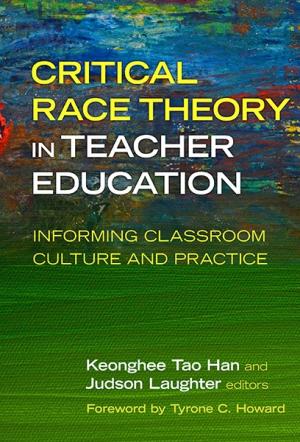
This important volume promotes the widespread application of Critical Race Theory (CRT) to better prepare K–12 teachers to bring an informed asset-based approach to teaching today’s highly diverse populations. Part I explores the tradition and longevity of CRT in teacher education. Part II, “Beyond Black and White,” expands CRT into new contexts, including LatCrit, AsianCrit, TribalCrit, QueerCrit, and BlackCrit. Part III looks beyond CRT to other epistemologies often dismissed in White conceptions of teacher preparation. Throughout the text, the authors collaborate across demographic lines to work together toward social justice and compassion. A closing chapter presents and synthesizes the lessons to be learned for teacher educators who want to prepare teachers to be agents of social change. (From the Publisher)
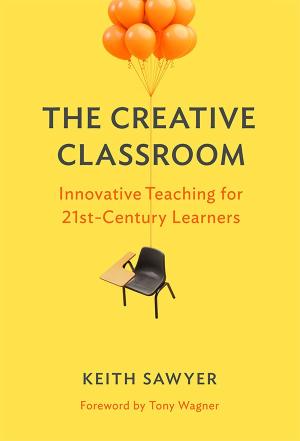
The Creative Classroom presents an original, compelling vision of schools where teaching and learning are centered on creativity. Drawing on the latest research as well as his studies of jazz and improvised theater, Sawyer describes curricula and classroom practices that will help educators get started with a new style of teaching, guided improvisation, where students are given freedom to explore within structures provided by the teacher. Readers will learn how to improve learning outcomes in all subjects—from science and math to history and language arts—by helping students master content-area standards at the same time as they increase their creative potential. This book shows how teachers and school leaders can work together to overcome all-too-common barriers to creative teaching—leadership, structure, and culture—and collaborate to transform schools into creative organizations. (From the Publisher)
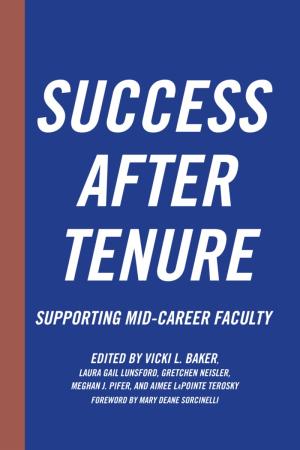
This book brings together leading practitioners and scholars engaged in professional development programming for and research on mid-career faculty members. The chapters focus on key areas of career development and advancement that can enhance both individual growth and institutional change to better support mid-career faculties. The mid-career stage is the longest segment of the faculty career and it contains the largest cohort of faculty. Also, mid-career faculty are tasked with being the next generation of faculty leaders and mentors on their respective campuses, with little to no supports to do so effectively, at a time when higher education continues to face unprecedented challenges while managing continued goal of diversifying both the student and faculty bodies. The stories, examples, data, and resources shared in this book will provide inspiration--and reality checks--to the administrators, faculty developers, and department chairs charged with better supporting their faculties as they engage in academic work. Current and prospective faculty members will learn about trends in mid-career faculty development resources, see examples of how to create such supports when they are lacking on their campuses, and gain insights on how to strategically advance their own careers based on the realities of the professoriate. The book features a variety of institution types: community colleges, regional/comprehensive institutions, liberal arts colleges, public research universities, ivy league institutions, international institutions, and those with targeted missions such as HSI/MSI and Jesuit. Topics include faculty development for formal and informal leadership roles; strategies to support professional growth, renewal, time and people management; teaching and learning as a form of scholarship; the role of learning communities and networks as a source of support and professional revitalization; global engagement to support scholarship and teaching; strategies to recruit, retain, and promote underrepresented faculty populations; the policy-practice connection; and gender differences related to key mid-career outcomes. While the authors acknowledge that the challenges facing the mid-career stage are numerous and varying, they offer a counter narrative by looking at ways that faculty and/or institutions can assert themselves to find opportunities within challenging contexts. They suggest that these challenges highlight priority mentoring areas, and support the creation of new and innovative faculty development supports at institutional, departmental, and individual levels. (From the Publisher)
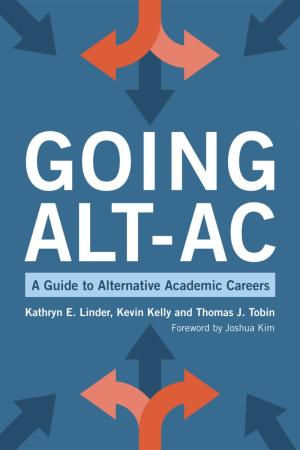
A growing number of people completing or holding graduate degrees now seek non-faculty positions—also called alternative academic, or “alt-ac” positions—at different stages in their careers. While an increasing number of people with doctoral degrees are hunting for a diminishing pool of tenure-track faculty jobs, most degree-granting institutions do not adequately prepare their graduate students to enter the new reality of the alt-ac job market. Yet the administrative ranks in higher education institutions are growing, as colleges and universities are creating a diverse range of positions that support teaching and learning efforts. Focusing on the range of potential alternative career choices, this highly practical book offers tools and prompts for readers who are: -Considering whether to choose an alt-ac career path -Seeking specific alt-ac positions -Advising graduate students or mentoring recent professional graduates -Encountering alt-ac career challenges The authors offer case stories—their own and those of colleagues across North America in alt-ac roles—with concrete examples designed to help readers pursue, obtain, and excel in a wide variety of alt-ac positions. The book can equally be used as a resource for graduate courses on professional development and job-market preparation. (From the Publisher)
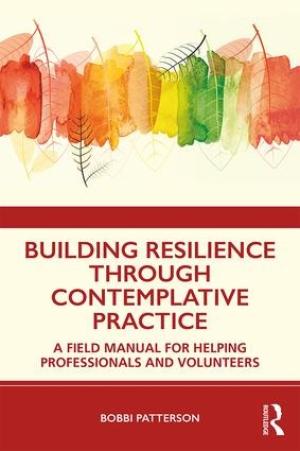
Recasting burnout as a crucial phase of service, Building Resilience Through Contemplative Practice uses real-world case studies to teach professionals and volunteers unique skills for cultivating resilience. Viewing service and burnout as interdependent throughout phases of stability, collapse, reorganization, and exploitation, the book uniquely combines elements of adaptive resilience theory with contemplative practices and pedagogies. Drawing on the author’s extensive experience working at the intersection of service and contemplative practices, this is the first book to demonstrate how and why professionals and volunteers can reframe burnout as an opportunity for resilience-building service. User-friendly case studies provide tools, skills, and exercises for reconstructive next steps. Chapters address personal, group, and structural levels of service and burnout. Illuminating the link between adaptive resilience and burnout as a normal and useful phase of service, Building Resilience Through Contemplative Practice is a necessary resource for professionals and volunteers across a wide range of service settings. (From the Publisher)
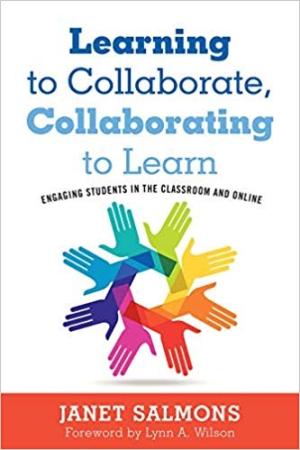
Students who know how to collaborate successfully in the classroom will be better prepared for professional success in a world where we are expected to work well with others. Students learn collaboratively, and acquire the skills needed to organize and complete collaborative work, when they participate in thoughtfully-designed learning activities. Learning to Collaborate, Collaborating to Learn uses the author’s Taxonomy of Online Collaboration to illustrate levels of progressively more complex and integrated collaborative activities. - Part I introduces the Taxonomy of Online Collaboration and offers theoretical and research foundations. - Part II focuses on ways to use Taxonomy of Online Collaboration, including, clarifying roles and developing trust, communicating effectively, organizing project tasks and systems. - Part III offers ways to design collaborative learning activities, assignments or projects, and ways to fairly assess participants’ performance. Learning to Collaborate, Collaborating to Learn is a professional guide intended for faculty, curriculum planners, or instructional designers who want to design, teach, facilitate, and assess collaborative learning. The book covers the use of information and communication technology tools by collaborative partners who may or may not be co-located. As such, the book will be appropriate for all-online, blended learning, or conventional classrooms that infuse technology instructional techniques. (From the Publisher)
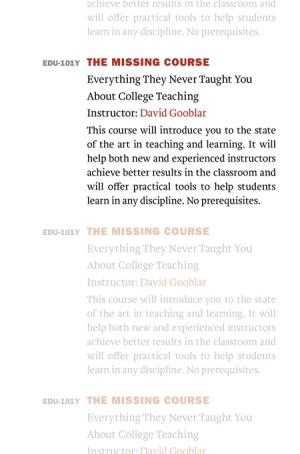
Professors know a lot, but they are rarely taught how to teach. The author of the Chronicle of Higher Education’s popular “Pedagogy Unbound” column explains everything you need to know to be a successful college instructor. College is changing, but the way we train academics is not. Most professors are still trained to be researchers first and teachers a distant second, even as scholars are increasingly expected to excel in the classroom. There has been a revolution in teaching and learning over the past generation, and we now have a whole new understanding of how the brain works and how students learn. But most academics have neither the time nor the resources to catch up to the latest research or train themselves to be excellent teachers. The Missing Course offers scholars at all levels a field guide to the state of the art in teaching and learning and is packed with invaluable insights to help students learn in any discipline. Wary of the folk wisdom of the faculty lounge, David Gooblar builds his lessons on the newest findings and years of experience. From active-learning strategies to course design to getting students talking, The Missing Course walks you through the fundamentals of the student-centered classroom, one in which the measure of success is not how well you lecture but how much students learn. Along the way, readers will find ideas and tips they can use in their classrooms right away. (From the Publisher)
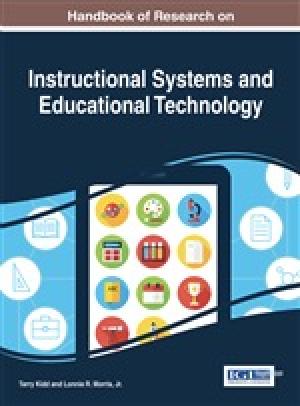
Incorporating new methods and approaches in learning environments is imperative to the development of education systems. By enhancing learning processes, education becomes more attainable at all levels. The Handbook of Research on Instructional Systems and Educational Technology is an essential reference source for the latest scholarly research on new models, trends, and data for solving instructional and learning challenges in education. Featuring extensive coverage on a wide range of topics such as distance education, online learning, and blended learning, this publication is ideally designed for academicians, practitioners, researchers, and students seeking current research on the latest improvements in instructional systems. (From the Publisher)
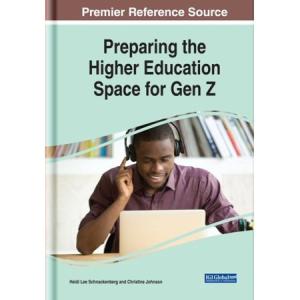
Generation Z views participatory technological interfaces as an integral part of their lives. Every experience in which they engage, particularly schooling, is viewed and experienced through that highly technological lens. At no other time in higher education has the nature of teaching and learning experiences been so defined by the technological interactivity of its student population. Thus, higher education needs to change to meet the needs of the incoming groups of students and expand upon ways in which they learn, communicate, and experience information. Preparing the Higher Education Space for Gen Z is an essential scholarly publication that delves into the specific challenges, issues, strategies, and solutions that are associated with using participatory social media, virtual communication, and other Web 2.0 innovations in higher education, and its particular implications for Generation Z. Including topics such as digital participation, learning environments, and mobile technologies, this book is ideally designed for higher education faculty, administrators, counselors, professionals, students, researchers, and academicians. (From the Publisher)
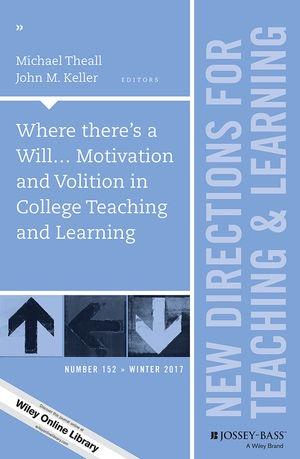
Motivating students a primary goal of education - is complex, to say the least. This issue focuses on a model for motivation, volition, and performance that acknowledges the importance of volition as action subsequent to motivation: action that leads to improved performance. This MVP model provides a framework for considering various teaching and learning topics and can be extended into other areas such as professional development. While models such as MVP are particularly helpful in establishing the relationships among constructs and in explaining theoretical bases, integration and application of such models are equally important. This issue discusses applications of the model and provide concrete ideas for integrating it into ongoing teaching practice. This is the 152nd volume of this Jossey-Bass higher education series. It offers a comprehensive range of ideas and techniques for improving college teaching based on the experience of seasoned instructors and the latest findings of educational and psychological researchers. (From the Publisher)